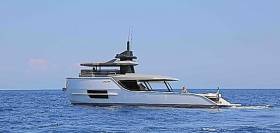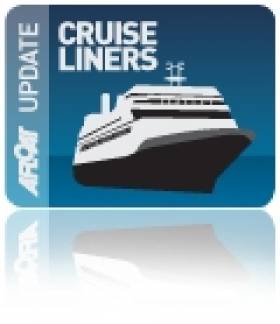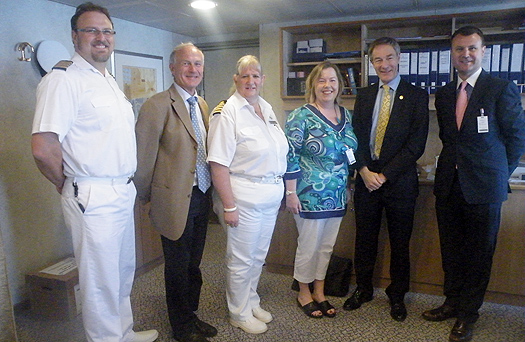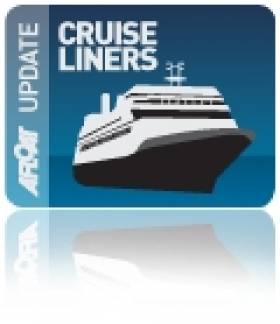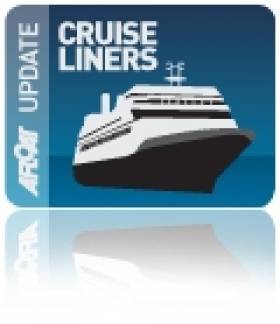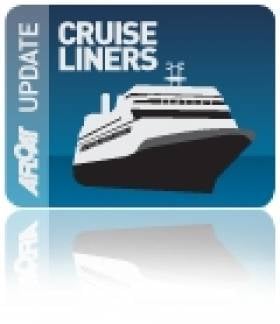Displaying items by tag: Arcadia
Arcadia Yachts A96 is a Star of the Monaco Superyacht Show This Weekend
Pellegrino's shipyard unveils its latest Arcadia model, the A96, at the superyacht boat show in Monaco this weekend.
Measuring 29 metres, this exquisite yacht will be showcased alongside other opulent and luxurious large yachts, providing an unmatched opportunity for enthusiasts to see the latest models.
The original model has already gained immense popularity, with two units sold to date.
The boat show in Monaco has become the ideal venue to exhibit this mega vessel and attract potential worldwide buyers (including Irish ones) seeking their next dream yacht.
Arcadia Sherpa 55 – A Glimpse at the Future of Motorboat Design?
What about this for a day cruiser, a shadow boat, a support vessel or even as a fishing boat? The Italian built Arcadia Sherpa 55 from Naples has an extremely short foredeck and expansive cockpit behind the superstructures. The most striking feature is its tug–style bow extending up to the upper deck.
The first of these boats for sale came with two spacious cabins, although three will be possible on future models. From the deck saloon there is a magnificent view through the large windows to aft over the cockpit that is located a level above the 13 m² tender garage. The flybridge with its breezy outside helm station can be fully enclosed with windows, be it to defy inclement weather or to provide protection from heat with the aid of the air conditioner.
Two Volvo Penta IPS 600 drives deliver a top speed of 25 knots.
Another Superyacht Visits Dublin as 'Arcadia' Berths at Dun Laoghaire Marina
#arcadia – Dun Laoghaire Marina welcomed another superyacht visitor this week when the 35.80m Arcadia berthed at the 800–berth south Dublin Bay facility. Not only does the impressive 'Arcadia' have gorgeous lines but as the 159th vessel to transit the Northwest Passage, she's also a serious long distance expedition motor yacht too.
This luxury vessel's sophisticated exterior design and engineering are the work of Tony Castro Design, the designer of none other than Royal Cork's own 1720 acclaimed sportsboat design. Arcadia was custom built in 2006 by Royal Huisman.
The visit follows June's biggest ever visitor to Dun Laoghaire when the marina said hello to 46m Superyacht Christopher.
Arcadia yacht has an alustar hull with an alustar superstructure with a beam of 8.24m (27'0"ft) and a 2.99m (9'9"ft) draft.
She offers accommodation for up to eight guests and is also capable of carrying up to seven crew onboard to ensure a 'relaxed luxury yacht' experience.
Reports from the Dun Laoghaire watefront say Arcadia owners and crew are having 'a wonderful time' touring the Dun Laoghaire locality, as well as the city centre, and are especially interested in visiting famers markets to sample the best of locally sourced produce.
#P&OCruises – Dun Laoghaire Harbour Company welcomed today the mid-sized cruiseship Arcadia (83,500 tonnes) under the command of Captain S C Breton, who is the first female to take this position for P&O Cruises, writes Jehan Ashmore.
Arcadia had departed her homeport of Southampton on Sunday and spent a leisurely passage before arrival this morning in glassy flat-calm seas and weather conditions more akin to the Mediterranean.
Passengers swam on board two of the ships outdoor swimming pools while the 285m long cruiseship was anchored motionless in the strong blue seas of Dublin Bay.
Enjoying the weather are more than 1,900 passengers from the UK and a sprinkling of other nationalities. Eighty per cent of her guests will be taking tenders ashore to visit Dun Laoghaire or excursions into the capital and the neighbouring Wicklow mountains.
The 2005 built exclusively adult-only cruiseship will be departing around teatime this evening on the 900 nautical mile passage to the Icelandic capital Reykjavik. After visiting two more ports in Iceland as part of the 14-night cruise Arcadia heads across the North Sea with calls to Norway before returning to the familar Southampton Waters.
In recognition of the Arcadia's maiden call, presentation ceremonies took place on board between Captain Breton and Don McManus, Dun Laoghaire Harbour Company (DLHC) board member and Chairman of Dun Laoghaire Business Association and Cathaoirleach Carrie Smyth of Dun Laoghaire-Rathdown County Council. Also in attendence was David Dingle, CEO of Carnival Corporation (UK).
The cruise liner sector is a growing business within the tourism industry and Dun Laoghaire Harbour is capitalising on such strengths and following the construction of the purpose-built cruise passenger tender pontoon.
The passenger pontoon facility caters for medium and large-scale cruiseships such as the Queen Mary 2 which made her historic first call in May which marked the start of the season with 14 cruise calls to the harbour in 2013.
Within the next two months, a further seven cruise vessels are scheduled to visit Dún Laoghaire Harbour including the five-masted Wind Surf, which is due to dock within the harbour walls.
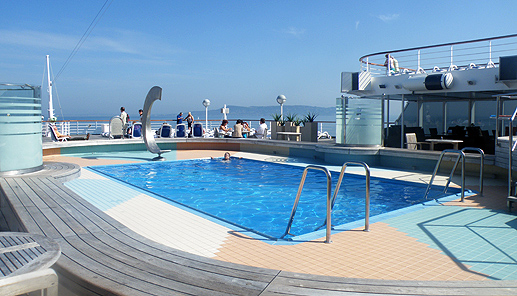
One of two swimming pools on the Arcadia and during her anchorage call in Dublin Bay. Photo Jehan Ashmore
Pictured (L-R) James Brown Deputy Captain, Don McManus (DLHC) and Chairperson Dun Laoghaire Business Association, Captain S C Breton, Cathaoirleach Carrie Smyth of DLRCoCo, David Dingle CEO Carnival Corporation (UK) and Nicky Logue, Fitzpatrick Castle Hotel. Photo: Jehan Ashmore
#CaptBreton – While Galway Bay is hosting The World today off Mutton Island, Captain S C Breton master of P&O Cruises Arcadia which is nearly twice the size, is set to make an anchorage call off Dun Laoghaire Harbour tomorrow morning, writes Jehan Ashmore.
Under her command, Captain Breton has the responsibility of the 83,500 tonnes vessel and leading a crew of 848 and more than 1900 passengers on the exclusively adults-only cruiseship. The call is to become the second cruise caller to Dun Laoghaire this season, following the successful and historic inaugural visit of Queen Mary 2 in mid-May.
The vast majority of her passengers are from the UK, the rest are a sprinkling of nationalities including those from Isreal, Malaysia, Japan and New Zealand. As for Captain Breton and her crew who are more diverse in terms of nationality than her guests are, with more than 25 countries represented and where the majority of the crew are mostly British, Indian and Filipino.
The 285m Arcadia was launched in 2005 by her patron, Dame Kelly Holmes. She is one of seven cruiseships of the P&O Cruises fleet which together last year made a spectacular cruise-in-company sail-past down Southampton Water for the 'Grand Event' which celebrated the 175th anniversary of the world famous company last July. Arcadia was the third vessel behind the sail-past leadship.
Incidentally Arcadia's first port of call after the event was to Dublin Port as previously reported on Afloat.ie and tomorrow's call will be her first to Dublin Bay since the visit just over a year ago.
Arcadia was launched in 2005 at the Fincantieri Cant. shipyard in Malfoncone though originally she was laid down at the Italian shipyard for Cunard Line as their Queen Victoria, however it was decided by her owners Carnival Corporation to transfer the vessel to her UK based cruising subsidiary.
As previously alluded she is an adult-only cruiseship which offers a relaxed pace in stylish surroundings that are also extravagant throughout her 11 passenger decks. A notable feature is her exterior glass-fronted lifts and expansive art collection, featuring no less than 3,000 works of art and creating a sophisticated air on board.
P&O Cruises Adonia… And the First Shall Become the Last
#CRUISE LINERS – The final cruise caller this year to visit Dublin Port tomorrow is P&O Cruises Adonia, which today is at sea, having departed Cobh Cruise Terminal yesterday, as previously reported. Albeit the smallest in the seven-strong P&O Cruise fleet, she was given pride of place as she led the company's 175th anniversary Grand Event held during the summer, writes Jehan Ashmore.
On that momentous day (3rd July) in Southampton, the 30,000 gross registered tonnes Adonia gathered with her considerably larger fleet mates (69,000 – 115,000 grt) and carrying between them 1,800-3,100 passengers each. Unlike her fleet mates however she exclusively caters for adults only and at only 710 passengers, provides for a more intimate cruising experience.
As each cruise ship took it turns to depart after one after the other, they formed a line down Solent waters where the maritime spectacle was an impressive display in seafaring skills and logistics as thousands of passengers had embarked to include Arcadia whose next port of call was Dublin.
The historic day to mark the origins of the famous company formed in 1837 was the theme of a packed out lecture presented by P&O Cruises Managing Director, Carol Marlow during last months' London Ship Show. Marlow, who was a former CEO of Cunard Line, gave an insightful and entertaining talk of the intensive preparations surrounding P&O Cruises day of celebration.
Despite all the planning, one major event that the P&O team could not arrange was for the sun to shine!..instead a rather misty dull overcast day lingered over the Hampshire port. Having said, many hundreds lined the Solent to watch the sail past as each vessel departed on seven cruises. To view a video of the splendid liners and heritage of the famous company click the series of videos HERE.
As for the London Ship Show which was organised by the Ocean Liner Society, this was to be the last time held under its current format where maritime memorabilia stands and lecture programme where provided to all those interested in the world of liners and ferries operating from the UK.
Three Masterpieces Set to Make an Impression in Dublin
Arcadia caters for the UK market and she is on a 13-night cruise which so far has included calls to North Shields, Tyneside, Invergordon, Shetland Isles, Glasgow, Belfast and Liverpool. After her call to the capital she heads for Cork and finally to St Peter Port, Guernsey.
Readers may note that the vessel is of the same design as of Cunard Line's Queen Victoria, which also called to Dublin in May and Cork. In fact Arcadia was to be given the regal name but the 2005 Italian built vessel was transferred from Cunard Line to P&O Cruises, which are under control of US-owned cruise giant Carnival Corporation.
Notable external features of the Arcadia are glass-fronted lifts, two pools, one with a skydome and an interior that is brimming with an art collection consisting of over 3,000 works. She has many facilities such as a three-tier palladium theatre, an intimate 30-seater cinema and gymnasium with an ocean view to inspire those exercising at sea. She was constructed in just twenty months by the Fincantieri shipyard, just outside Venice.
Likewise Eurodam has an extensive art collection theme that is based on the Dutch master's 'Golden Age' including "The Nightwatch, Two Minutes Later", a contemporary re-interpretation of Rembrandt's famous painting. In addition there are 17th-century watercolour maps by famed cartographer Johannes Vingboons.
Passengers on the 11-decked Signature-class can also enjoy the Pan-Asian restaurant and lounge surrounded by panoramic views, an explorer's lounge bar, an Italian restaurant adjacent to the lido, jewellery boutique, atrium bar, show lounge and a photographic and imaging-centre.
Last but not least to dock around lunchtime will be the 30,000 tonnes Ocean Princess, operated by Princess Cruises, another subsidiary of the Carnival Corporation. The 680-passenger / 181 m long vessel may be the smallest of tomorrow's callers and within the Princess Cruises fleet, but the former Tahitian Princess, which underwent an extensive dry-docking in Singapore last winter is well equipped with facilities.
She has a cabaret lounge, club restaurant and bar, casino bar, main pool and spa, steakhouse restaurant, panorama buffet, an Italian restaurant and the Tahitian Lounge. To see the work conducted at the dry-dock, you can view a slideshow by clicking HERE and to see the work in a completed state which also applied to her sister Pacific Princess, watch this VIDEO.
- Dublin Port
- port of Cork
- Dublin Bay News
- Princess Cruises
- P&O Cruises
- Cruiseships
- Port of Dublin
- Ports and Shipping News
- Cunard Line
- Dublin Port news
- Holland America Line
- queen victoria
- Fincantieri Shipyard
- Port of Dublin news
- Arcadia
- Eurodam
- Ocean Princess
- Irish cruiseship ports ofcall
- Dutch masters
- Rembrandt
- Onboard Art Collection
- Johannes Vingboons


























